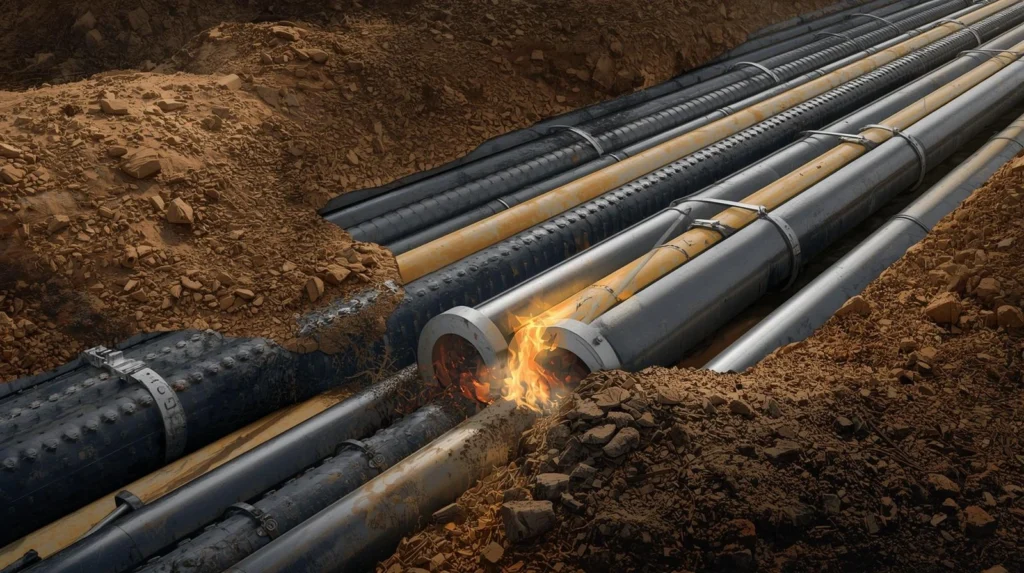Have you ever wondered how HDPE pipes can stand the test of time, even in harsh environments? In industries such as water distribution, oil, gas, and chemical industries, HDPE (High-Density Polyethylene) pipes are often the go-to solution for their durability, flexibility, and resistance to corrosion. But even the best products need attention to last longer.
In places with extreme weather, high-pressure conditions, or exposure to chemicals, ensuring the longevity of HDPE pipes requires specific maintenance practices. In this guide, we’ll discuss how to extend the lifespan of these pipes by focusing on key maintenance strategies and real-world examples from industries using HDPE pipes.
By the end of this article, you will know how to implement practices that will keep your HDPE pipes functioning optimally, saving costs on replacements and downtime.
Why is Maintenance Crucial for HDPE Pipes in Harsh Environments?
What makes HDPE pipes the best choice for harsh environments?
HDPE pipes are known for their excellent resistance to corrosion, high impact strength, and ability to endure high temperatures and UV exposure. These characteristics make them ideal for use in challenging environments like underground water systems, industrial applications, and regions with extreme weather conditions.
However, even the best pipes can experience wear and tear due to factors like improper installation, environmental stress, or neglect in maintenance. Understanding the root causes of wear and knowing how to address them is key to extending the lifespan of HDPE pipes.
Pro Tip: The right installation practices are just as important as regular maintenance. Incorrect installation could void warranties and lead to early pipe failure.
How Can You Prevent Physical Damage to HDPE Pipes?
What are the common causes of physical damage?
HDPE pipes can face physical damage from external forces, such as heavy machinery or soil movement. Stress from bending, crushing, or expansion and contraction due to temperature fluctuations can also weaken the pipes. These issues are especially common in construction sites and places with unstable soil.
Preventive Measures:
- Proper Burial Depth: Install HDPE pipes at the recommended burial depth to protect them from external impacts.
- Use of Protective Coatings: Coatings like anti-abrasion or impact-resistant layers can offer extra protection against physical damage.
- Monitoring for Ground Movement: Regular checks for ground settlement or soil displacement can prevent long-term damage.
Case Study: In an industrial plant, HDPE pipes experienced premature failure due to inadequate burial depths, causing them to crack under pressure. After adjusting the depth and adding protective coatings, the pipes saw a significant improvement in longevity.
How to Protect HDPE Pipes from UV Radiation?
What is the impact of UV radiation?
HDPE pipes are resistant to UV radiation to a degree, but extended exposure can cause degradation, leading to cracking, brittleness, and eventual pipe failure. This is particularly important for pipes installed above ground or in areas with intense sunlight.
Preventive Measures:
- UV-Resistant Coatings: Apply UV-resistant paints or coatings that protect pipes from harmful radiation.
- Bury Pipes Underground: Whenever possible, bury pipes to shield them from direct sunlight.
- Use of UV Stabilizers: Some HDPE pipes come pre-treated with UV stabilizers, which prevent UV damage.
Expert Insight: UV protection is essential for pipes exposed to direct sunlight for long periods. Installing shade structures or considering the use of black-colored HDPE pipes (which are better at absorbing UV light) can help mitigate damage.
How Can Temperature Extremes Affect HDPE Pipes?
What are the risks of extreme temperatures?
Extreme temperatures—whether high or low—can significantly impact the structural integrity of HDPE pipes. In cold climates, pipes may become brittle and crack, while in hot environments, they might expand or soften, potentially causing deformation.
Preventive Measures:
- Insulate Exposed Pipes: Use insulation materials around pipes in extreme climates to prevent them from freezing or overheating.
- Temperature Monitoring: Install temperature sensors to monitor fluctuations and ensure they remain within safe ranges for HDPE pipes.
- Heat-Resistant HDPE Pipes: Use specially designed HDPE pipes that can tolerate higher temperatures if your system operates in such conditions.
Real-World Example: A water distribution network in an arctic region used insulated HDPE pipes to prevent cracking from freezing temperatures. The pipes lasted well beyond their expected lifespan due to this investment in protection.
High-Quality Pipes & Fittings – Built to Last
How to Prevent Chemical Damage to HDPE Pipes?
What chemicals can harm HDPE pipes?
While HDPE pipes are resistant to many chemicals, prolonged exposure to certain aggressive substances like acids, solvents, or oils can cause corrosion and degrade the pipe material. Understanding the chemical compatibility of the fluid flowing through the pipes is essential.
Preventive Measures:
- Chemical Resistance Testing: Always perform compatibility tests between HDPE pipes and the materials they will carry.
- Use Protective Linings: In some cases, applying an internal or external lining can protect the pipes from harsh chemicals.
- Regular Inspections: Regularly inspect for signs of chemical damage, especially in industries handling hazardous materials.
Case Study: A petrochemical plant experienced reduced pipe life due to exposure to concentrated acid. After replacing the standard HDPE pipes with acid-resistant variants, the plant improved operational efficiency and reduced maintenance costs.
What is the Importance of Proper Installation Techniques?
How does installation impact the lifespan of HDPE pipes?
The lifespan of HDPE pipes is directly affected by how well they are installed. Proper alignment, joining methods, and ensuring that the pipes are not subjected to excessive stress during installation are crucial steps that prevent long-term issues like leaks, cracks, or joint failures.
Preventive Measures:
- Butt Fusion or ElectroFusion Joining: Use these high-quality joining methods to ensure strong and durable connections.
- Correct Sizing and Alignment: Ensure that the pipes are sized correctly for the intended application and properly aligned during installation.
- Avoid Overstressing: Don’t over-tighten the joints or install pipes under conditions that could lead to stress fractures.
Expert Insight: Proper installation not only prevents immediate damage but also reduces the need for costly repairs in the future.
What Routine Maintenance Can Extend the Life of HDPE Pipes?
Why is regular maintenance crucial?
Routine maintenance helps identify and address minor issues before they become major problems. In harsh environments, regular checks are essential to ensure that the pipes remain functional for as long as possible.
Preventive Measures:
- Visual Inspections: Regularly inspect exposed pipes for any signs of cracking, discoloration, or damage.
- Leak Detection Systems: Implement leak detection systems to catch potential failures early.
- Cleaning and Flushing: Periodically flush the pipes to remove sediment, scale, or blockages that could affect flow and pipe integrity.
Real-World Example: A municipal water system saw a significant improvement in the service life of its HDPE pipes by implementing a bi-annual cleaning and inspection program, reducing the frequency of pipe replacements.
Conclusion
Maintaining HDPE pipes in harsh environments may seem daunting, but with the right strategies in place, you can significantly extend their lifespan. By focusing on proper installation, preventive measures like UV and chemical resistance, and regular maintenance, your pipes will stay in excellent condition, avoiding costly repairs and replacements.
Don’t wait until a pipe failure disrupts your operations. Start implementing these maintenance practices today to ensure your HDPE pipes continue to serve you reliably, even in the harshest conditions.
FAQ Section
1. How often should I inspect my HDPE pipes in harsh environments?
Regular inspections should be performed every 6-12 months, especially for pipes exposed to extreme temperatures or chemicals.
2. Can HDPE pipes withstand freezing temperatures?
Yes, HDPE pipes are resistant to freezing but may become brittle if exposed to extremely low temperatures for prolonged periods. Insulation and proper installation help mitigate this risk.
3. How can UV radiation affect HDPE pipes?
Long-term exposure to UV rays can degrade HDPE pipes, causing cracks and brittleness. Using UV-resistant coatings or burying the pipes can prevent this.
4. Are there specific maintenance practices for HDPE pipes in industrial applications?
For industrial applications, regular cleaning, leak detection, and chemical compatibility checks are crucial to ensure the longevity of HDPE pipes.
5. What should I do if I notice cracks or signs of damage in my HDPE pipes?
If cracks or damage are detected, the affected section should be replaced or repaired immediately to avoid further damage or leaks.


